Shooting digital
by John Robinson
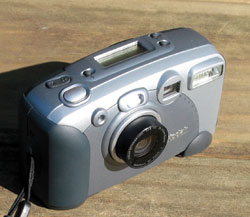
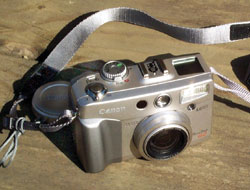
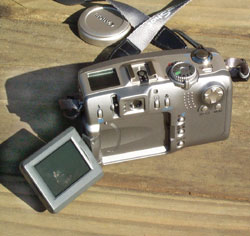
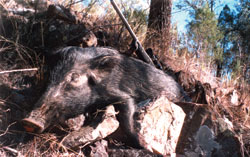
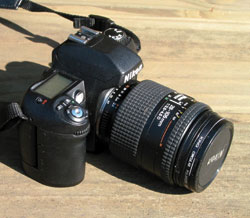 The real benefit of digital cameras for important
shots in the field is each shot can be reviewed as it is taken.
The real benefit of digital cameras for important
shots in the field is each shot can be reviewed as it is taken.
The most rapid advances in consumer technology have been in digital cameras. Less than five years ago, a digital camera was something of a novelty, purchased at relatively high cost and producing results that were greatly inferior to film cameras.
Early digital cameras almost required an extension cord to keep the power up to them and their image storage capacity was also quite limited - hardly an asset for those heading bush for a week or two.
I have had a basic digital camera for three years: a Kodak DC240, which is a 1.2 megapixel camera. For those not up with digital specifications, the resolution of the image is measured in the number of pixels on which data is recorded. A one megapixel camera has a CCD (the chip that collects all the light and converts it to digital data) sensor that is 1000 pixels in each direction.
For family snapshots, this is fine and will reproduce postcard-sized prints that look almost as good as a lab print. Much bigger than that and the pixels start to break up the image. To compare this with a 35mm film, it is quite easy to blow a 35mm color negative up to A2 size - about 900mmx700mm or poster size. To get equivalent resolution, you would need a digital camera with a resolution of about 20 megapixels and it would cost you as many mega dollars.
I mention these technical issues because those considering ‘going digital’ for taking their hunting shots will need to decide what end result is important to them. For example, I am not a great lover of mounted trophies, although I have some good deer, goat, chamois and tahr trophies. Instead, I prefer to have enlarged photos of my hunting experience that I can put up on my study wall. A low resolution digital camera will not provide that performance.
During the past year, digital camera technology has advanced rapidly, with a corresponding drop in cost. It is now possible to get three megapixel cameras for less than $1000 and five megapixel semi-pro cameras for about $2500. In addition, battery life has greatly improved, as has storage capacity.
Earlier this year, I purchased a high-end, non-pro-digital camera: a Canon G2, which was listed at $1900 when I first started looking. I bought it six months ago for $1550 and they can now be purchased for $1350. A four megapixel camera can produce high quality images up to A3 size and A4 prints are hard to pick from quality film prints. Like most other things, there are quality levels within particular ranges of digital cameras. The higher cost cameras of the same resolution will have more sophisticated technology associated with the CCD. This may provide better color reproduction and other image enhancements.
Most of the photos used to illustrate my stories in Australian Shooter this year have been taken with the Canon. My 35mm camera is a Nikon F80, so a high benchmark has been set for film quality with this outfit.
The image data is stored on a removable compact flash card. Other solid state storage devices are used on other models with similar storage capacity. A compact flash card is really like the hard drive on a computer. They come in various sizes, from 8Mb (megabytes) up to 256Mb and higher. A high resolution photo may use 2.5Mb or more of flash card space, but you can still store 100 images on a 256Mb card. The card can be changed over quite easily, so carrying a couple of flash cards allows a lot of photos to be stored.
When you get back to base, you can download all the photos off the flash card onto a computer to empty the flash card so it is ready for the next time.
My old Kodak digital will flatten a set of four AA batteries in a couple of days. The rechargeable battery in the Canon G2 has given me 200 photos or more before requiring recharging - a major benefit for outdoor use when 240V power supplies may be few and far between.
No non-professional digital cameras come with interchangeable lenses and prices for digitals with this feature start at about $5000. However, most digitals have some optical zooming capacity combined with some digital zooming feature to give them about 6x to 8x zoom capacity, which is handy in the field as bulky telephoto lenses needed for this magnification in a 35mm camera are not required.
The other feature of many digital cameras is their ability to focus at very short distances. My Canon G2 can focus down to a few centimetres simply by pressing the ‘close-up’ button on the control panel.
The other thing that takes a little getting used to is the use of the screen rather than the viewfinder. Most digitals have a fold-out color screen for composing the picture. This shows exactly what is going to appear in the photo. Most also have a viewfinder. This is okay for longer shots but parallax error comes in as the subject gets closer.
From a creative point of view, the screen gives a lot more flexibility. Rather than taking shots of trophies from eye level (boring), you can take them from ground level or from as far as you can reach above your head, if the camera has a pivoting screen. However, it can be hard to see in bright sunlight.
While all digital cameras come with their own built-in flash, they have another advantage over film cameras; they can vary their own ‘film’ speed to suit the conditions. In bright light, they can be set at 50 or 100 ASA and in low light a faster film speed can be selected. The better ones can also be used to shoot short video segments (30 or 60 seconds) and many have rapid shooting features.
They can also be set up to accommodate various forms of lighting - daylight, fluoro, tungsten and even moonlight. The electronics then compensate for the color cast caused by the light source.
The real benefit of digital cameras for important shots in the field is each shot can be reviewed as it is taken. I have taken some great hunting shots of people with terrific trophies to find their eyes are shut or their fly is undone when the prints come in a week after the trip.
I always shoot color transparency film on hunting trips with my Nikon and carry a little Olympus compact 35mm camera as a backup loaded with color print film. Most magazines prefer transparencies and good trannies always produce the best looking pictures. Exposure must be spot-on and most transparency film does not handle highly contrasting light very well (shade and bright sun).
Digital cameras are, in my experience, more accommodating in this respect and will generally produce a better outcome in difficult light conditions. You can also switch the camera from color to black and white or even sepia if you want moodier images.
For shooters and hunters, the next stage of digital photography is to load the selected images onto your computer and manipulate them to look as you want them to look. I use a program called Photoshop Elements, which came packaged with my scanner. Its big brother, Photoshop, is the benchmark professional program for image manipulation.
This program allows me to crop images of unwanted areas, manipulate the color and exposure, brighten dark areas and remove offending items from the image. For example, you might have a great trophy shot with an unnoticed branch or bit of grass in the wrong place. Photoshop Elements allows you to remove the offending item without interfering with the subject behind it.
It is amazing how quite poor photos (as long as they are in focus) can be enhanced with the digital manipulation tools available in these types of programs.
The industry has realised that not everyone has a computer or wants to spend $2000 just to process digital photos. Most new model digitals can print direct to a printer and many new printers will take the output of any digital camera and print it out.
Even quite inexpensive color printers can produce outstanding quality prints if glossy inkjet photo paper is used. Once photos are taken, the advantage of having a computer is they can be saved on a CD and archived almost indefinitely without losing quality. About 300 high-resolution images will fit on a CD and most film labs will run prints directly off CDs these days.
So, if you are considering taking the jump to digital for your outdoor photography, my advice is to get a camera no smaller than three megapixels in image size and make sure it has a reasonable battery life. I bought an additional 64Mb flash card, which is the equivalent to a 36-shot roll of film if high resolution settings are used.
Don’t throw your film camera away though. Digital prints are not as cheap as photos. Paper is about $1/per A4 sheet (enough for four postcard size pics). The big cost is the ink cartridges at around $50-$80 each, and will push the cost of each homemade print up to more than the $1 mark.
If you have a computer and don’t want to bother with a digital camera, a cheap option is to buy a scanner. A high range non-pro scanner can be purchased for about $500 and some decent ones can be found for half that price. A scanner can convert your color prints to digital images and you can have fun e-mailing your trophy pictures to your friends and family - after you have made sure your trophy has a world-class head.
